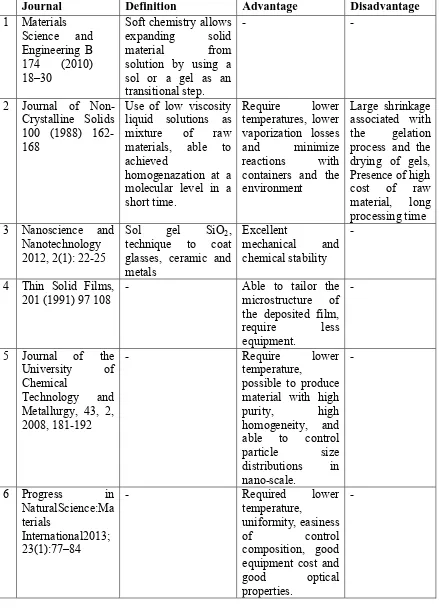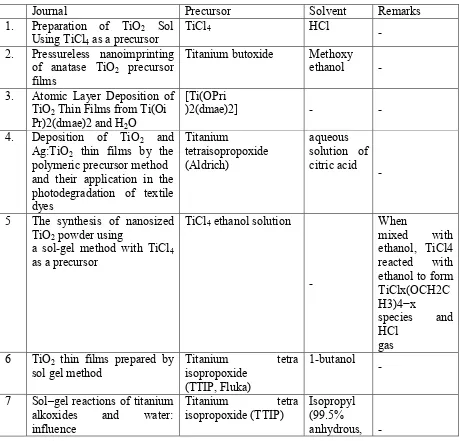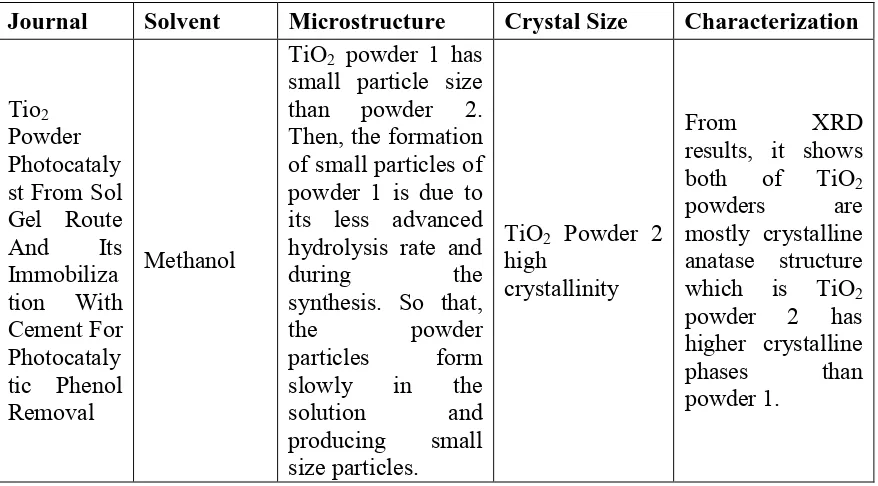UNIVERSITI TEKNIKAL MALAYSIA MELAKA
Effect of Mixed and Non-mixed Solvent on the Coating Properties of
Sol Gel TiO
2Thin Films
This report submitted in accordance with requirement of the Universiti Teknikal Malaysia Melaka (UTeM) for the Bachelor Degree of Manufacturing Engineering
(Engineering Materials) (Hons.)
by
WAN AMIRUL SHAFIZ BIN WAN ZULKIFLI
B051210158
910323-11-5797
DECLARATION
I hereby, declared this report entitled “Effect of Mixed and Non-mixed Solvent on the Coating Properties of Sol Gel TiO2 Thin Films” is the results of my own study except as
cited in references.
Signature : ………
Author’s Name : Wan Amirul Shafiz Bin Wan Zulkifli
APPROVAL
This report is submitted to the Faculty of Manufacturing Engineering of UTeM as a partial fulfillment to the requirements for the degree of Bachelor of Manufacturing Engineering (Engineering Materials) (Hons.). The member of the supervisory is as follow:
i
ABSTRAK
Pada masa kini seramik atau kaca biasanya digunakan untuk banyak aplikasi sama ada dalam industri, semikonduktor atau dalam kehidupan seharian. Sebaliknya, kita perlu mengekalkan tahap kebersihan kaca. Tambahan pula, bakteria juga hanya boleh tumbuh di permukaan kaca. Oleh itu, untuk mencegah pertumbuhan bakteria, salutan TiO2 digunakan untuk substrat kaca dan Titanium Tetra isopropoxide sebagai
pendahulu. Dari kajian yang lepas, mereka menggunakan beberapa teknik untuk menyalut kaca seperti teknik semburan, lapisan spin dan juga sol-gel. Dalam kaedah sol-gel, pelarut adalah satu bahagian penting untuk mewujudkan sol-gel. Pilihan tepat pelarut adalah penting dan kritikal kerana kebanyakannya sol-gel adalah perlu pelarut. Dari pelarut, kita boleh menentukan perbezaan kesan mereka kepada saiz kristal, fasa, dan juga pada kesan morfologi. Daripada tindak balas dengan TiO2, kita
boleh membezakan kualiti salutan untuk substrat dan kesannya kepada sifat penyelesaian. Walau bagaimanapun, kita juga perlu mengambil berat tentang ketepatan pelarut ditambah kerana apabila pelarut tidak tepat, kita tidak boleh membezakan kesannya kepada pendahulu. Dengan menggunakan pelarut, kita tahu bahawa kita boleh mendapatkan pelbagai jenis mikro dan kesan morfologi, contohnya dengan menambah metanol; kita boleh mendapatkan kehadiran fasa anatase dan rutil serta mempunyai saiz hablur yang kecil. Walau bagaimanapun, ia jarang digunakan dengan mencampurkan pelarut di mana dengan mencampurkan perbezaan pelarut boleh memberi kesan yang berbeza. Terdapat satu inovasi yang menarik untuk mengkaji kesan pelarut dengan sifat-sifat lapisan. Terdapat banyak kajian yang menggunakan pelarut akan mendapatkan hasil yang menarik sebagai kesan kepada salutan pada substrat. Jumlah TiO2 yang tinggi kandungan propanol
ii
ABSTRACT
Nowadays ceramics or glass is commonly used for many applications either in industrial, semiconductor or in daily life. On the other hand, we need to maintain the level of cleanliness of the glass. Furthermore, bacteria also can simply grow on the glass surface. Thus, to prevent the bacteria growth, TiO2 coating is being used for
glass substrate and Titanium Tetra isopropoxide as the precursor. From the previous research, they are using several techniques for coating the glass such as spray technique, spin coating and also sol-gel. In the sol-gel method, solvent is an important part to create sol-gel. The right choice of solvent is a critical important because mostly the sol-gel is need the solvent. From the solvent, we can determine the difference of their effect to the crystal size, phases, and also on the effect of morphological. From the reaction with the TiO2, we can distinguish the quality of the
coating to the substrates and their effect to the solution properties. However, we also need to care about the accuracy of the solvent added because when the solvent are not accurate, we cannot differentiate their effect to the precursor accurately. By using the solvent, we know that we can get various types of microstructure and morphological effect, for example by adding the methanol; we can get the presence of anatase and rutile phases and have the small crystallite size. However, it was rarely used is by mixing the solvent where by mixing the difference solvent can give the difference effect. There is an interesting innovation to study the effect of the solvent to the coating properties. By study a lot of solvent used as a solvent will get the interesting result as an effect to the coating and substrates. TiO2 coating solution
iii
DEDICATION
I dedicate to everyone that involves to this research, which is my supervisor, my family and my friend that has been supporting during conducting the study.
iv
ACKNOWLEDGEMENT
First of all I would like to express my thankfulness to all of the peoples involve in this study for supporting me for completing this final year report. A special thanks to my supervisor, Prof Madya Dr. Zulkifli Bin Mohd Rosli for his trustworthy patience, concerned, advice and encouragement throughout this study. Besides that, not to forget to our research teams to support me to complete my PSM 2.
v
TABLE OF CONTENT
Abstrak i
Abstract ii
Dedication iii
Acknowledgement iv
Table of Content v
List of Tables vii
List of Figures viii
List of Abbreviations, Symbols and Nomenclatures ix
CHAPTER 1: INTRODUCTION 1
1.1 Background 1
1.2 Problem statement 2
1.3 Objectives 3
1.4 Scope 3
CHAPTER 2: LITERATURE REVIEW 4
2.1 Introduction 4
2.2 TiO2 Coating
2.2.1 Advantages of TiO2 coating
2.2.2 Comparison with other materials
4 5 6
2.3 Sol Gel Technique 6
2.3.1 Process of Sol Gel 8
2.3.2 Precursor 9
2.3.3 Solvent 11
2.3.4 Additive 15
vi
2.4 Coating Properties 18
2.4.1 Thickness of Coatings 20
2.4.2
2.5.1 Non-Mixing Solvent 22
2.5.2 Mixing Solvent 24
CHAPTER 3: METHODOLOGY 26
3.1 Introduction 26
3.2 Sol Gel Solution Preparations 3.2.1 TiO2 solution
3.5 Characterization of Coatings
3.5.1 Scanning Electron Microscope (SEM) 3.5.2 Characterization Procedure
32 32 34
CHAPTER 4: RESULTS AND DISCUSSION 35
4.1 Results
vii
LIST OF TABLES
2.1 Previous Research about Sol Gel 7
2.2 Previous Research about Precursor used for TiO2 Sol Gel 9
2.3 Previous Research about Solvent used for TiO2 Sol Gel 11
2.4 Previous Research about additive used for TiO2 Sol Gel 15
2.5 Previous Research about Coating Properties for TiO2 Sol Gel 18
2.6 Previous Research about Solvent used for TiO2 Sol Gel 22
2.7 Effect of Mixing Solvent to the TiO2 Sol Gel 24
3.1 Chemicals includes in the Sol Preparation 26
3.2 Composition of TiO2 Solution deposited to Silica Glass substrate 27
3.3 Parameter ratio for Solvent used 27
4.10 Observation of the TiO2 Solution 36
4.11 Visual Observation of the TiO2 Solution 37
REFERENCES 50
APPENDICES 56
Appendix A: Gantt chart PSM 1 Appendix B: Gantt chart PSM 2
viii
LIST OF FIGURES
2.1 Reaction process of the TiO2 coating with bacteria 5
2.2 A Review for Sol Gel Preparation 8
2.3 Fundamental stages of sol-gel dip coating 17
3.1 Flowchart of the TiO2 coating preparation and characterization 28
3.2 Flow chart for the titanium dioxide (TiO2) solution preparation 29
3.3 Cleaning Substrate Flow Chart 30
3.4 Flow chart for dip coating 31
4.20 EDX spectrum for 100% Propanol Solvent 39
4.21 SEM images and EDX spectrum for 100% Propanol Solvent 40 4.22 EDX spectrum for 70% Propanol mix 30% Ethanol 41 4.23 SEM images and EDX spectrum for 70% Propanol mix 30% Ethanol 42 4.24 EDX spectrum for 30% Propanol mix 70% Ethanol 43 4.25 SEM images and EDX spectrum for 30% Propanol mix 70% Ethanol 44
ix
LIST OF ABBREVIATIONS, SYMBOLS AND
NOMENCLATURES
3D - Three dimensional
% - Percentage
TiO2 - Titanium Dioxide
CO2 - Carbon Dioxide
SiO2 - Silicon Dioxide
ZnO - Zinc Oxide
TTIP - Titanium tetraisopropoxide
HCL - Hydrochloric Acid
H2O - Water
TiCl4 - Titanium tetrachloride
TBOT - Tetrabutyl orthotitanate
XRD - X-Ray Diffraction
SEM - Scanning Electron Microscope
FESEM - Field Emission Scanning Electron Microscope
EtOH - Ethanol
MeOH - Methanol
PrOH - Propanol
BuOH - Butanol
CMC - Carboxy methy cellulose
PVP - polyvinyl pyrrolidon
HPC - Hydroxylpropy cellulose
PEG - polyethylene glycol
DSSC - dye-sensitized solar cells
TEM - Transmission electron microscope
�m - Micrometer
x
ml - milliliter
oC - Degree Celcius
SE - Secondary electron
BSE - Back-scattered electrons
CL - Athodoluminescence
CRT - Cathode Ray Tube
1
CHAPTER 1
INTRODUCTION
1.1Background Study
Sol-Gel method is a process for producing solid materials from small molecules. The process are refers to where the solid nanoparticles isolated in a liquid which is called sol agglomerate to produce a 3D network extending through the sol liquid where called a gel. On the other hand, Sol-gel method also is widely used for technique to coat glasses, ceramic and metals where it has an excellent mechanical and chemical stability (A. Shokuhfar, 2012). In addition, sol gel method also have their advantages where it was required lower operating temperature, easiness of controlling composition, uniformity, good optical properties, and also reasonable equipment cost (Sung Min Lee, 2010). Thus, sol-gel usages can be classified for the controlling composition, microstructure, and consistency of the method at low temperatures.
2
However, it was rarely used is by mixing the solvent where by mixing the difference solvent can give the difference effect. There is an interesting innovation to study the effect of the solvent to the coating properties. According to Y. Bessekhouad ET. Al. had found that for non-mixing solvent by using ethanol, the occurrence of anatase and rutile phases was near to that experimental which is 23 % of rutile phases, but by mixing the solvent, there are any possibility can occur depends on the type of solvent used where their coating properties it can be closed to the non-mixing solvent and it also can be totally different from the non-mixing solvent.
1.2 Problem Statement
Solvent plays an important role in a sol-gel method especially in determining films quality such as their effect on crystal size, phases, and morphology. For examples, M.A. Behnajady and his co-worker have shown that the used of different solvents like methanol, ethanol, and isopropanol that can give the different effect in morphology and microstructure. Leeyih et. Al. had found that the nature of chemicals for solvents like tetrahydrofuran, acetone, toluene, chloroform, and hexane can influenced the particle size and combination occurrence of titania considerably. Therefore, understanding the right solvents for right applications are crucial as it we can make lead to undesired properties of particular thin films if wrongly chosen.
Moreover, mixing and non-mixing solvent to TiO2 also can give the different effect for
3
also the photo electrochemical properties of the TiO2 thin film. In short, although using the same solvent, but by mixing with the different solvent, the coating properties can be different behavior.
By using the different solvent and solvent parameter like mixed and non-mixed solvent, we know that we can get various types of microstructure and morphological effect. On the other hand, by study a lot of solvent used and control their mixing ratio, it will get the interesting result as an effect to the coating and substrates. The need to understand the use of solvent systematically is worth it to study.
1.3 Objectives
The objectives in this study are:
I. To characterize the TiO2 coatings properties such as elemental analysis deposited
from mixed and non-mixed solvent.
II. To analyze the effect of mixing and non-mixing solvent on the morphological of TiO2 coating.
1.4 Scope
4
CHAPTER 2
LITERATURE REVIEW
2.1 Introduction
This chapter will discuss about the theory of TiO2 coatings, sol-gel technique, coating
properties and also will lead to solvent used in the TiO2 coating. In addition, this chapter
will highlight about the effect of mixing and non-mixing solvent used for TiO2 coating.
Even though the effect of solvent on TiO2 coatings has been performed before, however
the effect of mixing solvent and by controlling their mixing ratio was never performed before. So, this chapter will include the effect of ethanol and propanol, on structure and morphology properties.
2.2 TiO2 coating
Titanium dioxide is an inorganic substance that is stable in thermal condition, less solubility, nonflammable, and not categorized as hazard chemicals. For TiO2, the oxide
of titanium metal was occurs naturally in some types of rock and also sands. Titanium is a part of most common element in the earth’s layer and it is normally thought of as being inert chemicals. TiO2 coating thin film was widely used for elimination of air pollutants.
5
2.2.1 Advantages of TiO2 coating
There are a lot of advantages when using TiO2 coating which is as the photocatalyst, it is
a low cost material used. In applications today, they will be looking towards at low cost material first but it is effective to use. In addition, according to Marius Stamate ET, Al. when using TiO2, the reaction is quite fast at room temperature and atmospheric pressure
operating conditions. It is become more attractive for the sol-gel method because when the reaction is fast, no chemical reactants must be used and no side reactions are produced. Besides, the TiO2 become more interesting because it has a nature where a
wide spectrum of organic contaminants can be converted to water and CO2. TiO2 coating
can kill the cancer cells, bacteria and viruses under mild UV illumination. Other than that, it is also easily to oxidize non-toxicity and also have the chemical and physical stability. That’s make it as a good antimicrobial material. Figure 2.1 below is the illustration of how the TiO2 coating works on the substrates surface.
6
2.2.2 Comparison with other materials
TiO2 coatings are commonly used for ceramic coating because of their behavior which is
easily to oxidize non-toxicity and also have the chemical and physical stability. TiO2,
together with SiO2 and also ZnO are most usual additives that used with developed
applications in the nanoscale fields. The TiO2 antimicrobial activity which are giving the significant ecosystem for health precautions. However, there are rarely giving the consideration to the antibacterial activity of SiO2 and ZnO while they also creating reactive oxygen classes. These three reactive nanomaterials were hazardous to all organisms, with increasing of and also particle concentration. In addition, toxicity of these three compounds decreasing from ZnO to TiO2 to SiO2. However, the small
particle size did not affect the toxicity of these compounds. Besides that, the antibacterial activity was well-known under both either dark or light conditions specifying that mechanisms. These results focus the need for cautiousness during the use and removal of such manufactured nanomaterial to prevent chance to the environmental impacts.
2.3 Sol Gel Techniques
7
Table 2.1: Previous Research about Sol Gel
Journal Definition Advantage Disadvantage
8
2.3.1 Process of Sol Gel
The sol-gel process comprises solution, gelation, drying, and densification. The preparation of a TiO2 sol gel begins with an appropriate Titanium tetraisopropoxide
precursor which is mixed with deionized water and a common solvent to form a solution. Then, the hydrolysis process leads to the formation of mixing the element. Subsequent condensation of reactions producing the bonding. TiO2 gel was formed by
this process leads to a rigid, and the interconnected of 3D network containing of polymeric chains and sub micrometer pores. For the drying process, it is at ambient pressure, then, the solvent liquid was removed and significant shrinkage were occurs. The final material was known as a xerogel.
9
2.3.2 Precursors for TiO2 Sol Gel
Precursor is a compound that contributes in the reaction of chemical that produces other compound. Term "precursor" was used more definitely to refer as a chemical compound prior another in a metabolic path. Precursors were used for the synthesis of oxide systems by the sol-gel method that plays important role in various stages of the process is discussed. Highlighting is given to titanium tetraisopropoxide precursors and to their physical and chemical properties. Different precursor used, it will give the different effect to the sol gel.
Table 2.2: Previous Research about Precursor used for TiO2 Sol Gel
Journal Precursor Solvent Remarks
1. Preparation of TiO2 Sol
Using TiCl4 as a precursor
TiCl4 HCl -
2. Pressureless nanoimprinting of anatase TiO2 precursor photodegradation of textile dyes
TiCl4 ethanol solution
-
sol gel method Titanium isopropoxide tetra (TTIP, Fluka)
1-butanol -
7 Sol–gel reactions of titanium alkoxides and water: influence
Titanium tetra
10 of pH and alkoxy group on
cluster formation and properties
of the resulting products
Aldrich)
8 Photocatalytic degradation of Lissamine Green B dye by using
nanostructured sol–gel TiO2
films
9 Photocatalytic investigations of TiO2 nanocomposite thin
films prepared by peroxotitanic acid modified sol–gel method
10 Solar Photo catalytic activity of anatase TiO2 Nano
crystals synthesized by non-hydrolytic sol–gel method
Titanium (IV) chloride
(99.9%) benzyl alcohol
derived from aqueous particulate sol gel process
12 Preparation of continuous TiO2 fibers by sol–gel
method and its photocatalytic degradation on formaldehyde
tetrabutyl orthotitanate
(TBOT) anhydrous alcohol (Ethanol) - 13 Preparation and visible light
induced photocatalytic activity of H-PVA derived TiO2 composite loaded on
glass via sol gel method
Tetrabutyl titanate
11
2.3.3 Solvent
In sol gel method, solvent is important because from the solvent, we can determine the quality of the coating properties. From previous research, by using different solvent, we can get different effect on their crystal structure, phases and also morphology. The important thing here is we need to understand about the applications used to choose the right solvent because there are different properties for different applications. Besides, we also need to know the ratio of the solvent that need to mix with the precursor, time taken for stirring, aging time and also the molarity of the chemicals. All of these factors are important to get the proper sol gel with good surface morphology and microstructure. By observing how the rate of a reaction was affected with the changing conditions, sometimes, we also can learn specifically of what is happening at the molecular level. However, a little modification in the parameters conditions of the mixture, such as solvent, temperature, catalyst, concentration or time, it can produce large adjustments in the final properties of the material.
Table 2.3: Previous Research about Solvent used for TiO2 Sol Gel
Journal Solvent Microstructure Crystal Size Characterization


